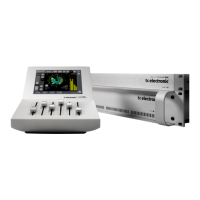86
MAssEnburG EQ
Introduction
More than one flavor of EQ
InrecognitionofGeorgeMassenburg’sgreatsenseof
audio and strong influence on previous TC processors, the
newMDWHiResEQisofferedasanlicensedalgorithm
option. The MDW design complements the TC alternatives
and therefore offers the user a choice between several
desirableEQflavors,eachwithspecificadvantages.Allof
them have processing capabilities worthy of handling any
critical signalpath.
System 6000 and MDW HiRes EQ
ThecombinationSystem6000/MDWHiResEQconstitutes
a 48 bit precision signal path from Input to Output. It comes
in2and6channelconfigurationswithflexiblelinkingand
absolute/relativerealtimeadjustmentproperties.The6
channel version features 6 identical processing channels
makingitequallysuitableforcontrolling5.1and6.0
signals.
Qualityequalizationisnotonlyaquestionofafinefilter
designwithhighbitresolution.Precisionintimingisjustas
important, as is conversion from Analog to Digital and vice
versa.Thehighresolutionrouting,extremelylowjitterand
pristine conversion environment provided by System 6000
bringoutthebestqualitiesinGeorge’sdigitalEQdesign.
Sample Rate
IftheSystemrateissetat44.1or48kHz,thesignalis
up-sampled to double rate, processed and down-sampled
toSystemrate.Thisapproachisonewayofmimicking
morepreciselythebehaviorofanalogEQsplusreducing
alias distortion.
TheEQcanalsobeoperatedat88.2or96kHz.Athigh
System rates, up/down sampling is bypassed, providing a
bit transparent signalpath at unity gain.
Bands and Filters
TheEQsfeature5parametricbandsperchannel.Outer
bands can be configured as shelving or 2nd order filters
(Butterworth). Band 1 filters can be switched between 2nd
and 4th order.
Allfivebandscoverthecompletefrequencyrange.Each
parametric or shelving band is capable of cut/boost over a
+/-25dBrange.
Channel Linking and operational Hints
In the 2 channel version, equalization of stereo material
shouldinitiallybeperformedinAbsolutelinkmode,i.e.
changes applied to Left channel will also be applied to
Right.Ifitisindicatedtomakedifferentadjustments
toLandR,thelinkisreleaseduntilthedesired
differences have been established. Now a Relative
linkcanbeenabled,preservingtheadjustmentoff-sets
betweenchannels,butnothavingtoadjustbothofthem
permanently.
In the 6 channel version, up to three different Absolute
linksmaybeset.Beforelinkchannelscanbechanged,
theLinkEnablekeyhastobeactive.Whenalinkis
established, the settings of the lowest channel number
in the group will be copied to the rest. The settings of all
channelsinalinkgroupwillremainthesameaslongas
thechannelsarelinked.Whenthedesirednumberoflinks
havebeenestablished,itisadvisabletoturnofftheLink
Enablefunctiontopreventagainstaccidentaleditingand
copying.Linkingofallchannelsmayserveasaquickway
to achieve an identical initial setting of all channels.
Latency
At44.1and48kHzsampling,delay(latency)is37samples,
whichequals0.84msat44.1kHzand0.77msat48kHz.
At88.2and96kHzsampling,delay(latency)is10samples,
whichequals0.11msat88.2kHzand0.10msat96kHz.
Notes
Because of the upsampling approach, latency is higher
atlowrates.Asareferencetotherealworld,it’suseful
to remember that 1 ms of delay equals one foot of extra
distance between source and microphone. 3 ms of delay
equals one meter of extra distance between source and
microphone.
The MDW Hi Res EQ 2 channel algorithm occupies:
@ Normal Sample Rate : 1/4 DSP Resource
@ Double Sample Rate : 1/4 DSP Resource
Algorithm Inputs/Outputs are distributed as follows:
E1 - E4
L
R
L
R
INPUT
OUTPUT
•
•
•
•
•
•
•
•
•
•
•
•
•
•
•
•
The MDW Hi Res EQ 6 channel algorithm occupies:
@ Normal Sample Rate : 3/4 DSP Resource
@ Double Sample Rate : 3/4 DSP Resource
Algorithm Inputs/Outputs are distributed as follows:
E1 - E4
1
2
3
4
5
6
1
2
3
4
5
6
INPUT
OUTPUT
•
•
•
•
•
•
•
•
•
•
•
•
•
•
•
•

